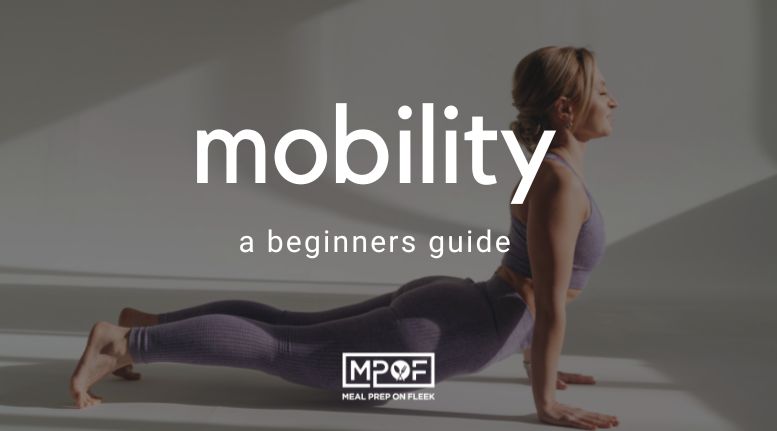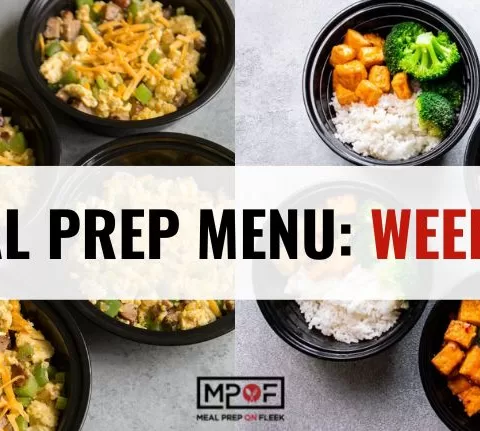Food is part of the equation, without a doubt, but what about movement. Check out this guide to mobility--it can help you reach your health and wellness goals!
You are doing everything right, from meal prep to exercise and everything in between. But you just can’t move the way you want to. Maybe it’s a tight back, stiff knees, or locked-up hips.
Maybe you've even heard a little bit about mobility training, but you aren’t sure what to do or even what it is. It has become somewhat of a buzzword in the health and fitness space, but what exactly does it mean? Are we talking about taking a weekly yoga class? Do chiropractor visits count? I’m sure you’re hoping I don’t tell you to touch your toes like you are in PE class again, right?
And furthermore, you might even be thinking, I'm fine. Nothing hurts right now. Why should I care about this right now? Why do we even need a guide to mobility?
While all these things have their place and can be a part of a mobility program, simply put, mobility goes far deeper.
It is worth noting that there are entire books written on mobility, so this is a condensed overview of what mobility is, why it matters, and how we can begin to improve it.
So What Is Mobility?
Mobility is the ability to move your body pain-free through full ranges of motion.
Mobility goes hand in hand with strength. We not only want to be able to reach the end ranges of our motion but want to be able to control our bodies in these positions. Having muscle control when, for example, you're in the bottom of a squat, means that you truly own that position.
Just as with exercise, nutrition, and our health in general, this is all very individual. Mobility needs are dependent on the person, where they are at in their journey, and what they want to achieve. For some people, it means simply moving in basic exercise. For others, it may be active stretching or banded joint mobilizations. It may also include muscle strengthening using weights, bands, or even your own body weight. Mobility measures can be designed to tailor specific imbalances in the body, strengthen one area, and alleviate pain. It's complex! It can even help prevent injury.
This is why we need a guide to mobility.
Why Mobility Matters?
Simply put, mobility is movement.
As we age, our mobility and muscle mass begin to decrease. We begin to lose the ranges of motion we once had access to as kids and even young adults. Think back to the last time you saw kids playing at a playground. Do they struggle to move? No, quite the opposite. Kids often are seen sitting in the bottom of a squat quite comfortably. However, at some point, whether we blame sitting all day or just getting older, we no longer have access to these positions in a pain-free way. This is where mobility training comes in.
As mentioned above, mobility has two major components.
The ability to move. No matter how hard we try, many of us cannot get into basic positions, whether it's the aforementioned bottom of a squat or stretching our arms up straight over our heads. You may be thinking, “You’re right, but does it really matter if my squat doesn’t break parallel or my arms can’t fully extend?”
It absolutely does. As we age, we lose mobility. So, as you grow older your problem can go from not being able to sit at the bottom of a squat to not being able to do a quarter squat. Maybe you're asking, what is even a quarter squat? Think about simple everyday tasks like using the restroom or getting off the couch. If your mobility is impaired, doing those simple tasks is considerably more difficult.
The ability to move without pain. This is the goal. We want you to move fully and without pain. Pain is different than discomfort and it is important that you determine which one you are feeling day-to-day when performing a mobility routine. Mobility training can be difficult at times, but it should feel similar to exercise discomfort or even mild pain—definitely not sharp pain.
How to Improve Mobility?
I know you are sold at this point on this whole guide to mobility and amping it up!
For the vast majority of people, rather than spending ten minutes touching your toes or doing a chest stretch, mobility should begin with full ranges of movement in your exercise training. Whether it is an air squat, pushup, or pull-up, be sure to control the entire movement and move through the full range, without pain.
So much of what we do with our bodies is connected, whether it’s our diet, mental health, exercise, or stress. Some of your mobility issues could be partially due to inflammation in the body.
READ MORE: Fight inflammation and improve mobility with the top ten inflammation-fighting foods.
Mobility training can be daunting to start and we certainly don’t want to leave you high and dry. Here are some specific mobility routines for some of the most common problem areas:
- Ankle Mobility
- Hip Mobility
- Shoulder Mobility
Try these out and let us know what you think. We are here for you in your health, fitness, (and now mobility) journey!
Sources
Eriksson, Keenan. “How to Master Your Mobility in 15 Minutes a Day.” Medium, Better Humans, 12 Oct. 2021, https://betterhumans.pub/how-to-write-yourself-a-15-minute-mobility-pres cription-c6c0067b926f.







